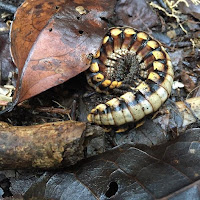 I've been in Costa Rica for almost a week now and in that time I have seen more mammals, insects, and glorious plants. I have hiked mountains daily, met quirky entomologists, and finally collected my first galls! As I mentioned in my last post, I'm here to study gall wasps, parasitoids of plants. But what I didn't anticipate was the diversity of galls from other insects. My first collected set were large bulbous stem galls made by some lepidoptera (butterflies and moths). Surprisingly one little wiggler resides in these large galls and they are fairly common in San Luis and Monteverde. But I didn't learn about all of this until I met Kenji.
I've been in Costa Rica for almost a week now and in that time I have seen more mammals, insects, and glorious plants. I have hiked mountains daily, met quirky entomologists, and finally collected my first galls! As I mentioned in my last post, I'm here to study gall wasps, parasitoids of plants. But what I didn't anticipate was the diversity of galls from other insects. My first collected set were large bulbous stem galls made by some lepidoptera (butterflies and moths). Surprisingly one little wiggler resides in these large galls and they are fairly common in San Luis and Monteverde. But I didn't learn about all of this until I met Kenji. |
| An Aggregation of Hyperparasitoids of Fig Wasps |
 | |
| Chrysina sp. found at Monteverde |
The biodiversity in Monteverde is much more rich than in San Luis. A few hundred feet of elevation takes you into the cloud forest (aka cloud factory) and with all that extra moisture the land teems with life. In the little time I spent up there I saw more species than I could wish for, including the silver Chrysina beetle. I also had the pleasure of digging through the station's collections and seeing beetles that were bigger than my hand for the first time. It was a religious experience and in moments like those, I feel reaffirmed in my love for insects.
 |
| Coleoptera collection at Estacion Biologica de Monteverde |
 |
| Undescribed species of walking stick |
After CASEM, the group and I toured the Monteverde's cheese factory. This strange building was built in the 1950's by 11 Quaker families who retreated from Alabama when the military drafts for WWII came through. I tried amazing cheeses and snacked on even tastier ice cream, but after hearing about those families I had a strange dream. In it I was babysitting many kids and couldn't keep myself from telling their father that he shouldn't have anymore children, considering how impossible it would be to take care of them all and based on the world's over-population. It didn't go over well.
 |
| Nyssodesmus python - milipede decomposer |
Alongside my research at the Ecolodge, I am also helping teach a comparative animal behavior class. I took this class while at Hendrix, but now get to see all the critters in person with their strange displays and social strategies. There's nothing I love more than sharing the wonders of nature with others and this trip is all about that! I'll be giving a lecture on Coevolution between Fig trees and Fig wasps this week and perhaps convert some students to loving Hymenoptera.
Wearing makeup in the rainforest is absurd, so for the first time in 10 years I have gone 1 week without doing so! This is a huge leap for me considering that just 2 years ago I was too uncomfortable to let anyone see me without makeup. Last year, during a life changing mission trip to Seattle, WA, I finally let some people see me without and photograph me without makeup on. This past semester was the first time I willingly took a picture of myself without makeup and sent it to my very sweet boyfriend who assisted in helping me be comfortable with my makeup-free face. This may sound silly to some, but in these past 10 years I have been digging myself out of the mentality that I have to wear makeup to be pretty. I've had bad skin for several years, which only assisted in making me makeup dependent, but now there is no excuse. The main aspect I have missed is the spf that is in my foundation. Monteverde gave me a nice sun kiss and my face and shoulders are now bright red. But hopefully I'll develop some melanin and get a tan. All I can think now is that I'm one step closer to being an Amazonian queen.
---------
Want more? I blog weekly, but I post photos everyday to my instagram: justanothernakedape


